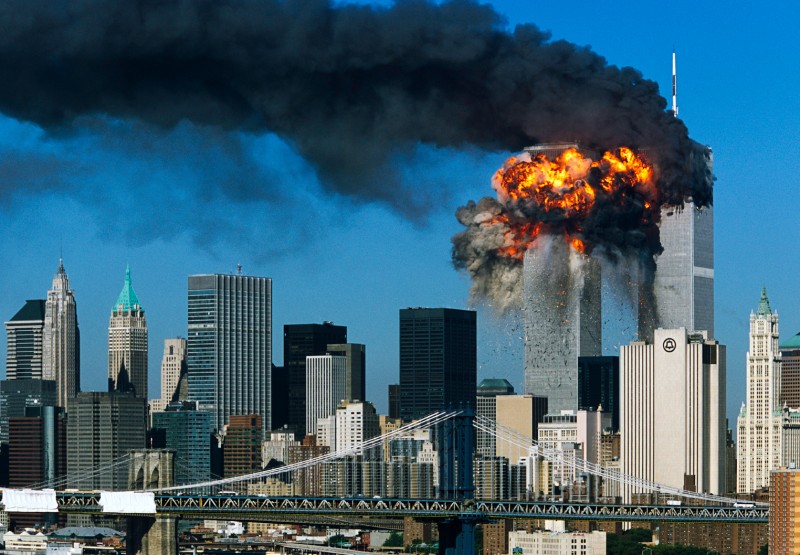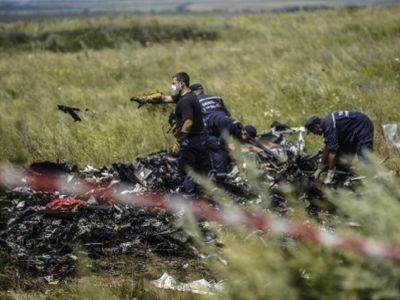
1. The event
Malaysia Airlines Boeing 777 (Amsterdam
—Kuala-Lumpur) departed from Amsterdam Airport Schiphol at 10:14 UTC
(14:14 Moscow Time) and was scheduled to arrive at its destination at
18:10 local time (22:10 UTC/2:10 Moscow time).
Echelon 330, including the 10 kilometers altitude that the crashed
Boeing was flying at, was open for international transit flights over
the territory of Ukraine. According to the data provided by the airline,
contact with the airplane was lost at 14:15 GMT, approximately 50km
away from the Russian-Ukrainian border. However, according to internet
portal Flightradar24, the airplane stopped transmission of ADS-B over
Snezhnoe (the last reported coordinates — 48.0403° northern latitude
38.7728° east longitude (G) (O)) after 13:21:28 UTC (17:21:28 Moscow
time, 16:21:28 local time) at an echelon of 33 thousand feet (a bit over
10 kilometers).
Later on, the wreckage of the airplane was found burning on the
ground on the territory of Ukraine. The plane crashed in the area of
village Hrabove (not far from Torez). No one from the passengers and
aircrew members survived.
2. Investigated questions
Under what circumstances did the airplane crash?
Who could be responsible for the crash?
3. Analyst group
A group of experts from the Russian Union of Engineers was gathered
to analyze the situation. The expert group included retired AA officers,
who had combat experience with surface-to-air missile systems, as well
as pilots experienced in using air-to-air weapons. The problem was also
discussed at the meeting of the Academy of Geopolitical Affairs, where
many different versions were tested and discussed once again. In the
course of the analysis, the experts used materials received from open
sources published in mass media. The situation was also analyzed with
the help of the Su-25 aircraft flight simulator.
Concluding the conducted research work, the following analytical materials are presented.
4. General source data for the purposes of analysis
4.1. Overall aerial situation in the area around Donetsk.
The overall aerial situation in the area around Donetsk was presented
at a Special briefing of the Russian Federation Ministry of Defense
regarding the crash of MH-17 in the airspace of Ukraine, on 21.07.2014.
The objective control data, registered from 17.10 pm to 17.30 pm
Moscow time, were presented at the briefing, during the speech of head
of the Main Operations Directorate, deputy of the Russian Air Force
Chief of Defence, Lieutenant General Andrey Kartapolov.
During the time period in question, there were three civil airplanes in the sky, all of which were on their scheduled flights:
• Flight from Copenhagen to Singapore at 17:17;
• Flight from Paris to Taipei at 17:24;
• Flight from Amsterdam to Kuala-Lumpur
Apart from these, Russian civil airspace control facilities recorded an
altitude gain by a Ukrainian Air Force aircraft, supposedly Su-25,
towards the Malaysian Boeing-777. The distance between the Su-25 and the
Boeing-777 was 3-5 km.

- The
aerial situation in the area of the crash of Boeing 777 (according to
the data of the Russian Federation Ministry of Defense)
4.2. Meteorological conditions in the area of the crash of the Boeing 777
Record of weather conditions in Topez, Donetsk Oblast, Thursday, 17 July, 2014.
| Time |
Weather conditions |
Air temperature |
Wind speed m/s |
Atmospheric
pressure |
Relative humidity % |
| 15:00 |
Overcast sky |
+31°C |
4.0 |
730 |
29 |
| 15:00 |
Overcast sky |
+31°C |
4.0 |
730 |
29 |
4.3. Source data from the Boeing 777 crash site
A more complete picture of the reasons for the crash of Boeing 777
can be achieved through the analysis of its wreckage. Examining the
pictures of the fragments, published on the Internet, one can notice
various damage on its fuselage – disruptions and breaks, holes with
edges from the internal and external sides of the fuselage, which speak
of a powerful external pressure against the airplane.

- A fragment from the wing of the Boeing 777

- A fragment from the fuselage of the Boeing 777

- A wing fragment from the aircraft

- A wing fragment from the aircraft

- A fuselage fragment from the aircraft

- A cabin fragment from the aircraft
Holes with inward edges catch the eye. These are round-shaped holes,
which are normally grouped. Such holes could only have round shapes in
the case of being cut with metallic elements, possibly with bars or
aviation cannon projectiles. This brings up the question: by whom and
how could such elements be delivered to the airplane and what could
these elements actually be?
4.4. Characterization of the Boeing 777 aircraft as an air target
The source data for the analysis of the given situation are technical
specifications of the Boeing 777 aircraft; its flight path; the
altitude and speed of the flight; heading alteration compared to the
initial flight plan; site of the crash; photo and video materials of the
plane wreckage; description of the range and the nature of wreckage
dispersion.

- Boeing 777
The most significant parameters of Boeing 777 serving for the purposes of the current analysis
| Wing span, m |
60.93 |
| Length of the airplane, m |
63.73 |
| Height of the airplane, m |
18.52 |
| Wing area, m2 |
427.80 |
| Maximum airspeed, km/h |
965 |
| Cruise airspeed, km/h |
905 |
| Operational range, km |
8910 |
| Service ceiling, m |
13100 |
The Boeing 777 aircraft is not considered to be a difficult aerial
target for AA systems. It is a high altitude aerial target (4000—12000
m) with a very large RCS (Radar Cross Section) – no less than 10m (the
RCS for an airplane of the Su-25 type is 0.5—0.6m), it has limited
maneuverability, and it has no capacity for anti-AA counteraction
(active and passive jammers, false targets, etc). It can be effectively
targeted both by military aircraft (interceptors or other types of
aircraft acting in the same altitude and speed range) as well as by AA
systems of object (S-200, S-300 type) or tactical (BUK-M1) types.
5. Technical aspects of the problem
In the present day practice of using anti-air systems engagement of
aerial targets is classified according to the following types:
A. type – termination of controlled flight
B. type – restricted continuation of controlled flight without possibility of landing
C. type – restricted continuation of controlled flight with possibility of landing and a subsequent repair of the aircraft
In this case, according to the available data, there is enough ground
to claim that we deal with (A) type target engagement – termination of
controlled flight.
We examined all major versions which had already been published by
experts from different countries. Turning to the technical aspect of the
problem, it can be claimed that the Boeing 777 was destroyed by
anti-air defense systems – either by using a surface-to-air missile,
launched from the ground, or by another aircraft employing its missile
or aircraft cannon.
Applying engineering methods and technical analysis, the experts of
the Russian Union of Engineers discussed both of these versions, which
represent almost the unanimous spectrum of opinions by experts and
specialists.
6. Version I. Boeing 777 was shot down as a result of using a surface-to-air missile, for example BUK-М1

- AA missile 9K37M1 BUK-М1
Technical characteristics of the AA missile 9K37M1 BUK-М1
| The start of mass-production |
1983 |
| Targeting range, km |
|
| —F-15 airplane types |
3..32—35 |
| Targeting altitude, km |
|
| —F-15 airplane types |
0,015..22 |
| Number of simultaneously engaged targets |
18 |
| Single shot kill probability SAM |
|
| • Of a fighter |
0,8..0,95 |
| • Of a helicopter |
0,3..0,6 |
| • Of a cruiser |
0,4..0,6 |
| Maximum velocity of engaged targets, m/s |
800 |
6.1. Evidence supporting the first version
6.1.1. The probability for the effective shooting down of an aerial
target of the Boeing 777 type by an AA missile 9K37M1 BUK-М1 is high, as
the plane was moving at a 10100 echelon, at the speed of 900 km/h. Such
parameters could make it an aerial target for BUK-M1. The probability
for successfully hitting such a target by a BUK-M1 AA system is
0.8-0.95, as a consequence, it is technically possible to hit an air
target of this type.

- A group of Ukrainian AA missile systems
The Ukrainian troops group around the site of the crash site included
3—4 systems of the BUK-M1 type. This information was published by the
Russian Ministry of Defense. Head of the main Operation Directorate of
General Stuff, Lieutenant General Andrey Kartapolov, emphasized the fact
that the Russian military possesses photos of separate Ukrainian troop
locations, made from space, including photos of Ukrainian army divisions
in the southeast of Ukraine, particularly, BUK systems 8 km from
Lugansk. In the morning following the crash of the Malaysian airliner,
Russian control facilities discovered a BUK-M1 AA missile system around
the Zaroshenskoe village.
On that same day that system was redeployed towards the Donetsk area -
towards the area where the militia troops were positioned. We consider
these data to be objective and reliable.
6.1.2. Also, the Russian Federation Ministry of Defense stated that
Russian military officers recorded the operation of a radar of a
Ukrainian BUK-M1 AA missile system on the day of the crash of the
Malaysian liner Boeing 777. The target location and guidance system
Kupol 9С18 is a three-axis coherent-impulse target locator performing
the transmission of information about the aerial environment to the
command observation post of the 9С470 AA missile system 9K37 BUK. The
9С18 radar is capable of detecting and identifying aerial targets at a
distance of 110-160km, with an identification range for low-altitude
targets (under 30m) of up to 45km. Such a radar could be used for the
detection and tracking of a Boeing 777.
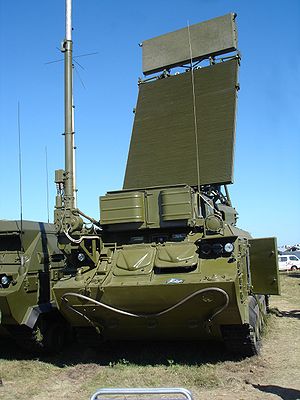
- Radar 9С18М1 «Kupol»
Radar 9С18М1 Kupol
| Coverage area: |
|
| In azimuth, degrees |
360 |
| In elevation angle, degree |
0-40 |
| Instrumented range, km |
10-160 |
| Resolving power: |
|
|
In range, м |
400 |
| In azimuth, degrees |
3-4,5 |
| In elevation angle, degrees |
3-4,5 |
| Continuous operation time, h |
48 |
| The set up and clotting time, min. |
5 |
Maximum velocity, km /h 65
6.1.3. However, experts of the Russian Union of Engineers find it
important to note that the launch of a BUK-M1 missile is accompanied by
the following significant audio-visual factors:
• Significant noise effect, both at missile launch time and during its flight, especially at altitudes between 100 and 3000m.
• A powerful flash at the launch site (Photo 10).
• A condensation trail, formed by the missile as a result of missile fuel burning on its flight trajectory (Photo 11).
• A flash and a characteristic picture in midair at the point of convergence of the missile with the target. (Photo 12).
6.1.4. The version that a BUK-M1 AA missile was used in this
incident, according to the experts, has a number of vulnerable aspects,
making it questionable:
а) Up to now no one has provided reliable evidence of the a
“surface-to-air” missile launch, which is known to be accompanied by
significant noise and visual effects. Its condensation trail goes into
the clouds and stays in the air for up to 10 minutes. The sound wave
produced during the launch of the missile can be heard within a radius
of 7-10 km around the launch site.

- Launch of a BUK-M1 AA missile
b) The flight of a surface-to-air missile is accompanied by a very
loud noise. Its flight can be visually traced due to the trail formed as
a result of the missile fuel burning (condensation trail).
In this case, there is no record of a trail in the form of a dense
white condensation from the burning of fuel, as well as of a vapor path,
which appears and stays for a few minutes after the launch and is well
visible within a radius of no less than 10km from the launch site.

- BUK-M1 AA missile during flight
c) The detonation of the warhead has a characteristic configuration,
which can be seen from the ground under clear weather conditions.

- Air target shot down by a BUK-M1 AA missile
The surface-to-air missile 9М38 is equipped with a dual-mode solid-fuel engine (general operation time about 15 seconds).
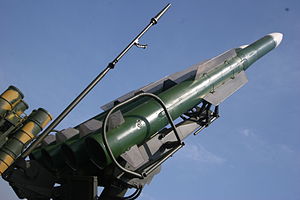
- AA missile 9М38 BUK-M1
Surface-to-air missile 9М38
| Missile length |
5,5 m |
| Diameter |
400 mm |
| Flaps width |
860 mm |
| Missile weight |
685 kg |
| Warhead weight |
70 kg |
The surface-to-air missile, with 40-70kg of warhead payload, explodes
not inside of the target, but in its proximity, at a distance of 50-100
meters.
The warhead detonation causes an aerial shockwave, which results in a
high-speed fragment distribution. The fragments are capable of breaking
an airplane fuselage, but taking into account the dimensions of a
Boeing 777 (63.7m length, with a large wingspan of over 60 m), they
still cannot destroy the airplane, causing its fragmentation into
several smaller parts, as is the case with aircraft that are 7-10 times
smaller in size. When hitting a Boeing 777 such fragments may cause
disruptions of fuel flow and lead to the leakage of fuel over the
fuselage and wings and its subsequent ignition leading to a fire.
d) Similarly, in the case that the hydraulic system had been damaged,
the Boeing-777 would have lost control, or control would have become
extremely difficult (shooting down type «В»). If an aircraft as big as
the Malaysia Airlines Boeing-777 had been hit by a surface-to-air
missile, the crew might have been able to warn flight services of the
situation created onboard the aircraft. However, according to the
information presented by mass media, nothing of the kind has been
registered in the decoded data of the aircraft recorders.
e) The crash of the airplane took place during daytime, in a highly
populated area, where there were not only numerous military observers
monitoring the air environment, but also many reporters equipped with
video cameras, as well as local residents, having digital cameras and
cellphones with cameras. It is also worth noting that the launch of a
BUK-M1 surface-to-air missile requires the participation of at least a
combat crew, which makes a stealthy launch rather difficult.
It would be logical to assume that pictures and video recordings
depicting the situation from various angles and displaying several
stages of the flight of the missile, would have instantly appeared on
the internet (the numerous amateur video recordings of the meteor impact
near Chelyabinsk are a good example of that). However, local residents
recorded only the fact of an explosion in the air and the falling of
body fragments near their houses.
f) During the crash of the Boeing-777 airplane, an American satellite
was overflying the territory of Ukraine. Because of this, Russian
military officers believe that the American side should publish
satellite images made at the moment of its crash, if Washington
possesses any such images.
Conclusions from the first version:
The data and considerations above pose very
significant challenges to the version according to which the Malaysian
Boeing 777 airliner was shot down by a BUK-M1 surface-to-air missile
system.
7. Version II. Boeing 777 was shot down as a result of
another aircraft (one or multiple) using its missile and/or aircraft
cannon equipment.
7.1. Evidence in favor of this version:
7.1.1. In the airspace around the area where the Boeing has crashed,
numerous witnesses claim to have seen a military aircraft (some people
say there were two), supposedly an air superiority fighter, as they
derived from its characteristic features and speed (the flight altitude
of an air superiority fighter is 5000-7000m, and the velocity is around
950km/h or more).
They also heard the sound of an airplane in the clouds. Presumably, these could have been airplanes of MiG-29 or Su-25 type.

- MiG-29
MiG-29
| Maximum velocity –high altitude \on the deck |
2450 km/h (М=2,3)\1300 km/h |
| Maximum rate of climb, m/s |
330 |
| Acceleration time from 600 to 1100 km/h, from1100 to1300 km/h, s |
13,5\8,7 |
| Takeoff airspeed, km/h |
220 |
| Service ceiling, m |
18000 |
| Operational range (without a drop tank\with one drop tank tank\with 3 drop tanks), km |
1500\2100\2900 |
| Maximum turning rate, °/s |
23,5 |
| Operational acceleration, g units |
+9 |
MiG-29 armament includes a single-barrel cannon GSh-301 (30 mm, 150
rounds of ammunition, firing rate of 1500 shots/minute) in the left wing
root extension. For engaging air targets 6 short range R-60М or short
range R-73 guided missiles with IR Seekers can be installed on the 6
below-wing stations of the MiG-29; 4 medium range guided missiles R-27RE
with radar location or with R-27TE IR navigation system Р-77.
Also, according to the data of the Ministry of Defense, on 17 July,
Russian air control means registered altitude gain by an airplane of
Ukrainian Air Forces, presumably, a Su-25, moving towards the Malaysian
Boeing 777. The distance between the two airplanes did not exceed 3-4
km.

- Su-25
Armament: One 30-mm 2-barrelled autocannon GSh-30-2 in the lower
forebody with 250 rounds of ammunition. GM: air-to-air R-3 (АА-2) or
R-60 (АА-8)air-to-surface Kh-25ML, Kh-29L or S-25L.Containers SPPU-22
with a 2-barrel 23-mm utocannon GSh-23L with 260 ammunition rounds.
Su-25
| Wing span, m |
14.36 |
| Weight, kg |
|
| Maximum takeoff weight |
17600 |
| Maximum airspeed, km/h |
|
| At cruise altitude |
975 |
| High altitude |
М=0.82 |
| Operation range, km |
1850 |
| Mission radius, km |
|
| High altitude |
1250 |
| At cruise altitude |
750 |
| Service ceiling, m |
7000—10000 |
It should be noted that Su-25 specifications allow it to gain an
altitude of 10.000m and above for a short period of time. Its standard
armament includes air-to-air missiles R-60, which are capable of
engaging and hitting targets at a distance of 10km, of which 8km is a
guaranteed range. Moreover, it does not even need to come close to the
target, but only to reduce the distance down to the required engagement
range.
7.1.2. The Russian Federation Ministry of Defense stated that Russian
military officers fixed the operation of a Kupol radar, belonging to an
Ukrainian AA missile BUK-M1 battery, on the day of the crash of the
Malaysian liner Boeing 777.

- Statistics of Ukrainian radar activity in the area of the Malaysian Boeing 777 crash
Operation of this radar can indirectly point to a military
deployment of aircraft, as radars are regularly used for airspace
reconnaissance and for transferring information to aircraft direction
centers, i.e. they provide source data for flight officers’ work in the
course of an interceptor’s or and interceptor group flight during
“combat air patrol” missions or during ambush activities. Usually,
attacks are performed according to target guidance from the ground, both
head-on and in pursuit.
7.1.3. On radars, the Su-25 is displayed in the same way as the
MiG-29, as their radar cross sections are similar. The operational
service ceiling of the MiG-29 is 18013m, so the altitude at which the
Malaysian airliner was moving, 10100m, could easily be reached by a
MiG-29. The MiG-29 has two high thrust engines, allowing it to attain a
speed of 2000km/h.
7.1.4. The data on meteorological conditions can also count in favor
of the version that the Boeing 777 was attacked by another aircraft.
Meteorological conditions from 15:00 to 18:00, 17.07.2014 in and around
the city of Donetsk, were marked by rain and an overcast sky. Flight
paths of passenger airplanes lie above the lower border of high-echelon
clouds. At this altitude, only cirrus cloud can form. Those are separate
white-colored fibrous clouds, which are thin and transparent, and
rarely contain dense or flaky formations. They are arranged in the form
of bundles and stripes, passing all along the sky and meeting at the
horizon. They show perfectly well through the sky. The average height of
the lower border is 7-10km, while the width can be from hundred meters
up to several kilometers.
An attack by a fighter aircraft with a rapid ascent, from below the
cloud layer could be quite unexpected for the crew of the Boeing 777.
Such an attack could not have been discovered visually from the earth
either due to the dense layer of clouds in the medium and lower cloud
echelons.
Thus, it can be claimed with a certain degree of certainty, that the
Boeing 777, conducting a horizontal flight at the altitude of 10000m,
could actually be in the lethal range of aircraft cannon or missile
armament of a fighter aircraft, be it MiG-29 or Su-25.
7.1.5. Thus the logical question arises: which particular weapon was
the cause of the shooting down of Malaysian Airlines Boeing 777?
Missile armament
In terms of missile armament, MiG-29 as well as Su-25 can carry short range guided missiles R-60M
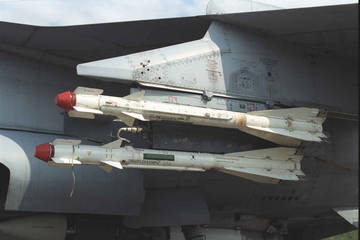
- R-60M missiles on the external sling of the airplane
Р-60М
| Length, m |
2,14 |
| Diameter, m |
0,12 |
| Wingspan, m |
0,39 |
| Weight, kg |
45 |
| Warhead weight, kg |
3,5 |
| Speed |
2,5M |
| Target kill altitude range |
0,03...20 |
| Maximum launch range, Front/Rear hemisphere |
10/8 km |
| Minimal launch range Rear hemisphere, km |
0,3 - 0,25 |
MiG-29 is equipped with a 30mm GSh-301 cannon, with a fire rate of
1500 rounds per minute. The cannon is armed with 150 rounds, which
contain a tungsten alloy. The effective range of firing at air targets
is 200-800m, and 1200-1800m for ground targets. Such type of rounds exit
cleanly, leaving holes of a perfectly circular shape. They do not
explode inside the cabin, are not incendiary-based, but are able to kill
the crew and cause the destruction of the cabin, which is typical for
the entrance and exit holes configuration: entry holes – with edges bent
inwards, exit holes - on the opposite wall - with edges bent outwards.
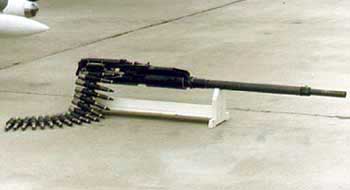
- Aircraft Cannon GSh-301
The Su-25 is equipped with a GSh-2-30 aircraft cannon.
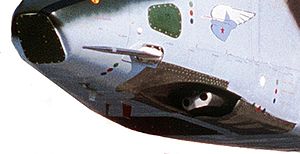
- Aircraft cannon GSh-2-30
GSh-2-30 (GSH-2-30K)
| Delivery vehicles |
Су-25, Су-39, (Ми-24П) |
| Weight |
|
| Shot weight |
390 г |
| Ammunition weight |
832 г |
| Cannon weight |
105 (126) кг |
| Specifications |
|
| Caliber |
30 мм |
| Number of barrels |
2 |
| Allotment of rounds |
250 (750) патронов |
| Rate of fire |
(300—2600) выст/мин |
| Effective range for air targets |
200—800 м. |
Apart from that, the Su-25 can carry SPPU-22 containers with the 2-barrelled 23-mm cannon GSh-23L.
During combat usage, both types of cannon ammunition can cause
fuselage damage similar to that visible on the wreckage of the Boeing
777.
Conclusions for the second version:
Thus, based on the opinion of the analysts of the
Russian Union of Engineers, a complex shooting down of the Boeing 777
airplane has taken place, both by a short-range air-to-air guided
missile and a 30-mm aircraft cannon or a SPPU-22 container with the
2-barreled Gsh23-L cannon. Furthermore, a laser rangefinder or a laser
aiming device could have been used when firing the target, which allowed
to significantly increase the shooting accuracy. This conclusion can be
made from the nature of damage and the fragment distribution: there are
both circular holes, which are usually caused by cannon fire, and
explosive damage, which indicates a missile with arrow-type submunition.
8. Wreckage analysis
If we examine the first version of the crash, the location of holes
in the wreckage surfaces and the fuselage clearly shows that there is no
typical picture of a plane being affected by the missile system BUK-M1
submunition, which would otherwise leave highly remarkable and typical
evidence of damage. In this case we see that there is no such evidence
on the wreckage fragments.
According to experts, in the case of a BUK-M1 AA missile system hit,
there should have been traces of numerous specific holes caused by the
submunition elements from the missile warhead. However, there is no such
evidence present in the photos taken at the crash site.
As to the possibility of such damage being inflicted by the usage of
short range “air-to-air” missiles, it should be noted that the R-60
(Su-27) and R-73 (MiG-29) missiles are short range low-duty missiles
with infrared homing. Their lethal range only 3-5m, with a guaranteed
kill only in case of a direct hit. The warhead of the prior weighs
3.5kg, while the latter carries a 5kg warhead. They have thinly chopped
tungsten wire in their warheads. These are rather low-power missiles,
meant exclusively for small-sized targets. Such missiles follow thermal
wake and are mainly meant to destroy the engine of the targeted
aircraft.
It would be more logical to assume that the damage presented in Photo
19 is more indicative for an aircraft cannon round of GSh or SPPU type.
Boeing777 wing damage is not indicative for submunition elements of a BUK-M1 AA missile system.

- Boeing 777 wing surface damage

- Boeing 777 cabin damage
The picture of entry and exit holes in the cockpit area (control
cabin) of the Boeing 777 fully corresponds to the assumption that it was
caused by being shot through by approximately 20-30mm rounds from a
fighter cannon. This supports the second version of the crash. The same
can be said about the nature of fragment distribution over the fuselage
of the plane. From the left side the edges of fragments of the control
cabin fuselage are rolled up from inside to outside, which points at
significant damage inside the cabin as a result of dynamic pressure of
missiles over its right side.
There are characteristic entrance holes and several exit holes
visible on the fuselage. The edges of the holes are bent inwards, they
are much smaller and are round-shaped. Exit holes are less precisely
shaped, and their edges are bent outwards. Additionally, it is visible
that the exit holes pierced the aluminum covering twice and bent it
outwards. I.e., the striking elements (judging by the impact type,
aircraft missile rounds) broke through the cockpit. Open rivets were
also bent outwards.
Boeing 777 fragment Fuselage damage is clearly visible – break through holes, caused by a 20- to 30-mm cannon.
Distinctive inward bends of the fuselage indicate a cannon round impact.

- Boeing 777 cover damage nature

- Boeing 777 fuselage damage nature
Boeing777 fragment.
Rivets blown out.
Destruction of the fuselage with edges bent outwards due to an
internal dynamic impact, either caused by an explosion inside the plane,
or a sudden and rapid change of internal pressure at high altitude.
The general typology of the holes and their location lead us to the
conclusion that, most probably, the Boeing 777 was attacked by an
aircraft cannon GSh-2-30, or an SPPU-22 container with a two-barreled
23mm cannon GSh-23L. The target zone was the control cabin, and the
rounds, breaking through the cockpit, affected the wing surface as well.
(see Photo. 20).
Both types of cannon rounds during combat usage cause damage to
aerial targets similar to that which can be seen on the fragments of the
Boeing 777.
The nature of the holes on the fragments of the plane fuselage,
present in the currently available information sources, allows claiming
that the airplane was shot down by aircraft cannon and missile armament
of a combat aircraft.
9. Re-enactment of the event
Based on the considerations stated above, the following conclusions can be made:
9.1. Regarding to the circumstances of the Malaysia Airlines Boeing 777 crash.
Malaysia Airlines Boeing 777 was conducting the flight
Amsterdam-Kuala-Lumpur, on 17.07.2014, according to the tunnel set by
the air traffic controllers. It is most probable that manual steering
was offline and the airplane was flying in autopilot mode, performing
horizontal flight following the route which was laid out on the ground
and adjusted by Ukrainian air traffic controllers.
At 17.17–17.20 the Boeing 777 was in Ukrainian airspace, in Donetsk
area, at the altitude of 10100m. An unidentified fighter aircraft
(presumably Su-25 or MiG-29), which was previously at a lower echelon,
on a head-on course in a layer of clouds, ascended rapidly, unexpectedly
emerging in front of the passenger plane out of the clouds and opened
fire at the control cabin (cockpit), using 30mm or smaller cannon
armament. The targeting could have been performed not only by the pilot
of a fighter aircraft in “free hunt” conditions (using the aircraft
radar), but also by a navigation officer on the ground, using the
airspace data received from ground-based radars.
The cockpit of the airliner was damaged in the result of numerous
rounds hitting the aircraft fuselage. The control cabin was
depressurized, which caused the instant death of the crew, due to
mechanical influences and decompression. The attack was quite unexpected
and lasted only a fraction of a second. Due to the surprise situation,
the crew was unable to give any alarm signals intended for such
situations, as the flight was following its scheduled route and the
attack was unexpected for everyone.
As neither the engines, nor the hydraulic system, nor other devices
crucial to the continuation of the flight, were set out of operation,
the Boeing 777 continued its horizontal flight in autopilot mode (which
is a standard situation), perhaps gradually losing altitude.
After that, the pilot of the unidentified fighter aircraft maneuvered
and repositioned himself into the rear hemisphere of the Boeing 777. He
entered an engagement course, performed the targeting using onboard
target tracking equipment, and launched a R-60 or R-73 air-to-air
missile (one or multiple).
As a result of the missile impact, the entire cabin was
depressurized, the flight control system was incapacitated, the
autopilot was switched off, the plane ceased its horizontal flight and
went into a tail-spin. The created g-forces caused a mechanical
disruption of the airframe at high altitude.
As indicated by the available flight recorder data, the plane fell
apart in the air, but this is possible mainly in the case of vertical
falling from a 10000m altitude, which can typically happen only in a
case of exceeding the maximum allowed g-force. As a rule, such a
tail-spin can be explained by the inability of the crew to control the
airplane as a result of some emergency case in the cabin and subsequent
instant depressurization of the cockpit and passenger compartment. The
destruction of the airplane took place at a high altitude, which
explains the fact that the wreckage of the plane was dissimilated over a
territory over 15 km².
9.2. Regarding the party responsible for the death of 283 passengers and 15 crew members.
On 17.07.2014 the armed forces of the self-proclaimed Donetsk
People’s Republic possessed neither appropriate fighter aircraft capable
of engaging an air target similar to the Boeing 777, nor an airfield
network, nor radar detection devices, targeting and guidance equipment.
Fighter aircraft of the Russian Federation Armed Forces did not
violate the airspace of Ukraine, which is confirmed by both the
Ukrainian side and by third parties performing space-based
reconnaissance over the territory of Ukraine and its airspace.
To ascertain the truth, it is required to objectively and impartially
investigate all the circumstances of the Malaysian Boeing 777 crash, to
question thousands of residents in the area who might have seen
anything. Naturally, the surveys must be conducted by highly experienced
specialists. Asking relevant questions is both a strict science and a
sophisticated art of coming close to the truth. Crucial information is
hidden in the wreckage and fragments of the crashed airplane, but this
very information can easily be eliminated, distorted and concealed. It
should not be forgotten that there are always people involved who seek
to conceal each and every real fact. An indirect confirmation of this is
the fact that on August 8th Ukraine, The Netherlands, Belgium and
Australia signed an agreement allowing the disclosure of information
regarding the investigation of the crash only at the consent of all
parties involved.
“The investigation proceeds with inspections and other investigatory
activities – declared the Speaker of Ukrainian General Prosecutor’s
Office, Yuri Boychenko, - their results will be announced upon the end
of the investigation and at the consent of all the parties, who have
signed the relevant agreement”.
Delays and deviation from carrying out a comprehensive objective
investigation with the participation of reputable international
organizations, raise doubts that the involved parties will actually
present the real circumstances of the Malaysia Airlines Boeing 777
crash.











































